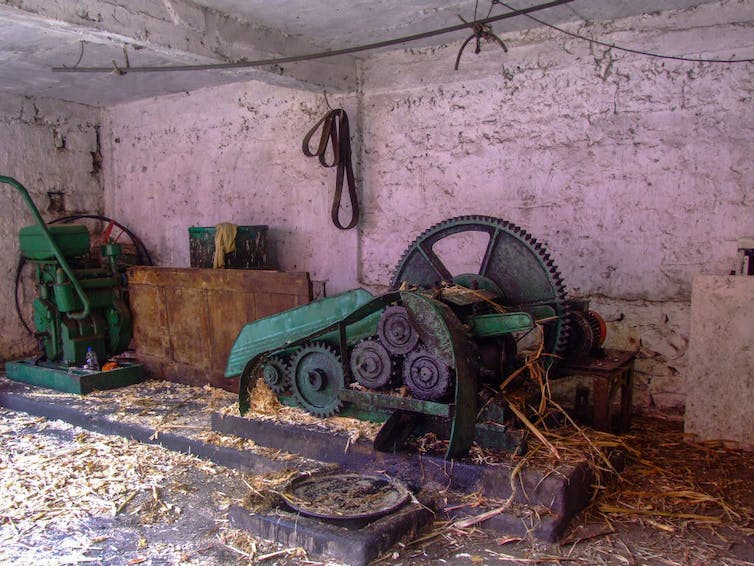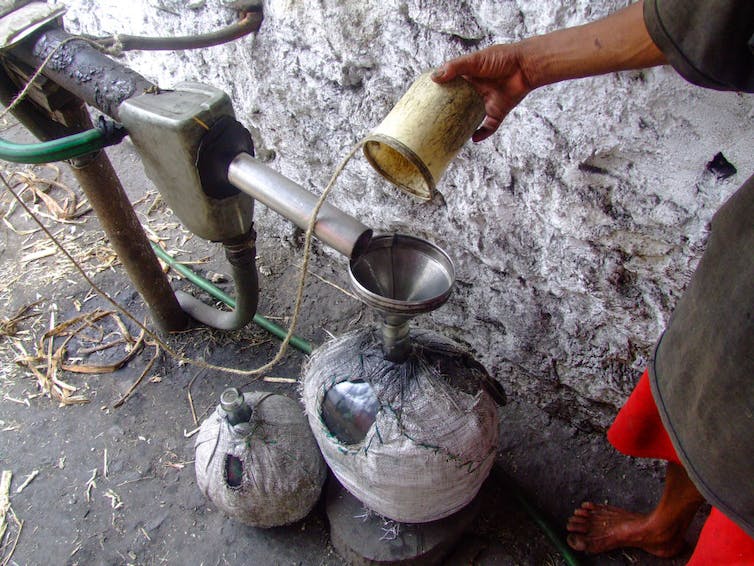Inside the grogue wars of Cabo Verde

At what point does a craft spirit no longer qualify as craft?
For centuries on the archipelago nation Cabo Verde off Africa’s west coast, farmers have produced a sugar cane-based craft spirit known as “grogue.” The liquor – an effervescent spirit with light grassy notes – has a rich cultural legacy and has historically been made in limited quantities by skilled workers using traditional distilling methods.
We’ve been studying tensions between some traditional producers and the government, which seeks to more strictly regulate the production of the spirit to popularize it in international markets.
The industrialization of this drink could be a boon for a struggling rural economy. However, some small-scale producers are being forced to close shop, unable to meet new regulatory demands.
A brief history of grogue
The history of grogue reflects the story of the islands themselves.
After the archipelago was discovered by European mariners between 1455 and 1461, the islands became a stopover along Atlantic trade routes, a place for ships to resupply and their new crews to embark. By 1490, Portuguese merchants brought enslaved peoples from the African mainland to grow crops, particularly plantation sugar cane, which largely failed due to degraded soil and lack of consistent rain.
The vast majority of Cabo Verde’s sugar cane is grown on the island of Santo Antão.
South Africa Gateway, CC BY-SA
Today, 82% of the arable land in Santo Antão, the country’s second biggest island, is still planted with sugar cane, which represents about 30% of the island’s GDP. Grogue, which uses sugar cane as its base, doesn’t rot and can be kept for years, which makes it an attractive export.
On July 5, 1975, Cabo Verde became one of the last African colonies to achieve independence. The nation’s newly independent government quickly moved to promote domestic agriculture through subsidies and investment, with unanticipated consequences on the grogue economy.
The decision to subsidize desired staples throughout the islands, such as refined sugar in 1993, resulted in an increase in grogue production – not from freshly pressed sugar cane, but from imported sugar. The glut of industrial sugar impaired the quality and value of grogue and became known colloquially as “merdon” or the “grogue of democracy.”
In 2008, the Confrérie du Grogue de Santo Antão, a guild of grogue producers, claimed grogue was being threatened by quality control issues and subsidized imported sugar. The guild lobbied for stricter government regulation to protect grogue’s legacy and cultural importance.
Regulating grogue
As a result of this lobbying, the government passed laws in 2015 and 2018 to establish rules governing the production of grogue, such as the banning of the use of refined sugar. The regulations considered national and international food standards, environmental protection, public health, and consumer and producer rights.
The law strictly defined grogue as a sugar cane spirit produced in Cabo Verde, specifically from the distillation of naturally fermented syrup that was directly pressed from Cabo Verdean sugar cane.
Once the regulatory apparatus was established after the COVID-19 pandemic, however, many small distilleries were forced to stop production because they couldn’t meet the new fermentation, storage and labeling standards.

A machine for crushing sugar cane to make grogue on Santo Antão, the second-largest of Cabo Verde’s 10 islands.
Jon G. Fuller/VW Pics/Universal Images Group via Getty Images
Instead, these farmers sent their relatively meager sugar cane harvests to larger processors, since it was no longer cost effective to produce grogue in small batches, or they left the enterprise entirely.
The new regulations primarily affected artisanal distillers throughout the main island of Santiago, which has more small-scale production sites. Most of the larger producers are in Santo Antão, where 80% of the country’s grogue is made.
Be careful what you wish for
In some contexts, small-batch production represents high quality and care – French cheeses, Italian olive oil and Kentucky bourbon, for example. In others, it signifies cheapness and inferior quality.
Cabo Verdean grogue can possess both elements, leading to highly charged debates over its value.
Almost 35% of Cabo Verde’s population participates in agriculture, and a deep and complex agricultural ethos has been cultivated over the centuries in what scholars Aminah Fernandes Pilgrim and João Resende-Santos describe as a “fading and failing rural economy.”
Does scaling up to meet industrial standards hold the key to rural renewal? Or will it create insurmountable barriers for small-scale producers, closing one more path out of poverty?
That is the current conundrum facing Cabo Verde, which has implications for other places where craft spirit production is highly valued as a cultural asset and is scaling up.
Cabo Verde and grogue go hand in hand, and locals, diasporas and tourists seem to broadly support the expansion of sugar cane cultivation and grogue distillation. Many local consumers see grogue as a quality drink that’s better than cheaper, imported alternatives. It represents a piece of cultural heritage and is key to rural economic development.

A man distills grogue at a small distillery on Santo Antão.
Jon G. Fuller/VW Pics/Universal Images Group via Getty Images
However, our analysis shows that the shift toward industrialization has deep implications for food security and public health.
Farmers producing grogue can use money they earn from grogue to pay school fees and achieve some financial stability.
Yet regulatory efforts to improve quality and consistency of grogue may have inadvertently and negatively affected small producers.
Improperly or illegally made grogue is now being confiscated and destroyed, pushing clandestine producers back underground. Agricultural figures from the World Bank suggest that there may be more grogue being made than available sugar cane to produce it, which indicates that refined sugar is still being used to make poor-quality merdon.
Of course, improperly produced grogue could get people sick. And it goes without saying that any alcohol consumed – regardless of how it is produced – can lead to alcoholism, violence and drunken driving.
It’s somewhat ironic that a local grogue guild of artisanal producers lobbied for new legislation to enhance the quality and highlight the cultural significance of their product. These efforts, however, have ended up pushing the smaller outfits – the kind most likely to use traditional methods – out of business, into cooperative arrangements or underground.
On Cabo Verde, all of the elements of craft spirits that make grogue special – a connection to people and place, a unique taste and a symbol of local celebration and identity – are in danger of being lost.







